Imagine a life where pain takes a backseat, where mobility and comfort are your trusted companions.
Whether you’re seeking relief from the relentless pain of osteonecrosis or looking to support a loved one on this path, our blog aims to be your source of knowledge for a pain-free life.
So, let’s continue this enlightening journey together as we delve into the intricacies of osteonecrosis treatments – ” A path to freedom from the relentless ache and stiffness.”
Dealing with osteonecrosis can be a challenging journey, but with advancements in medical science, there is scope for those affected.
Let’s take this informative guide to better understand and manage osteonecrosis.
Osteonecrosis: A Brief Overview
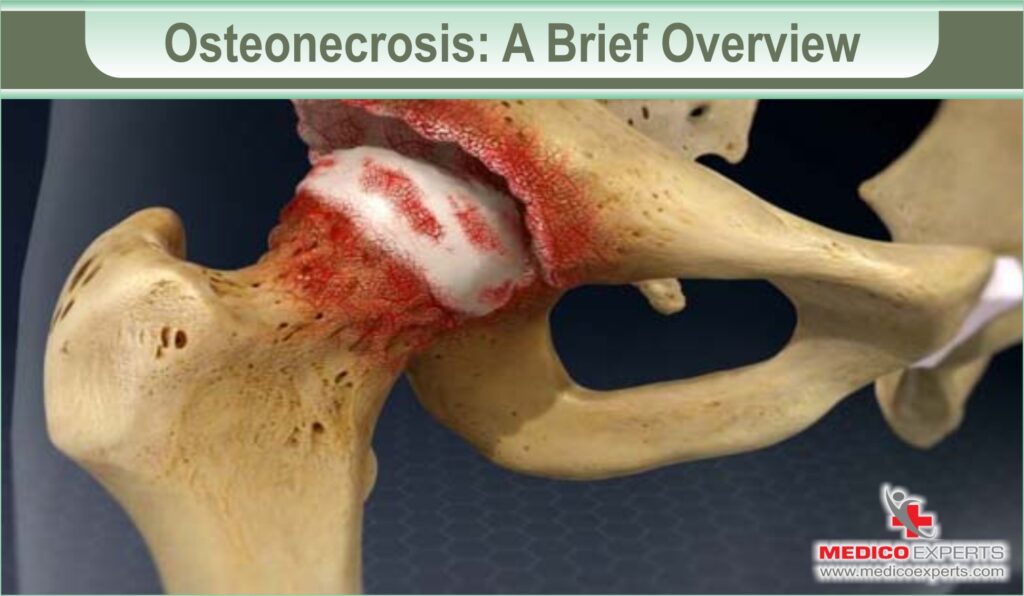
Osteonecrosis, also known as avascular necrosis, is a disorder in which bone tissue dies owing to a lack of blood flow.
This can lead to:
- Pain,
- Joint damage, and
- Even disability is left untreated.
But fear not, various treatments and approaches are available to help manage osteonecrosis effectively.
But before we go ahead with treatments let’s understand the causes and symptoms of osteonecrosis.
What Are The Causes of Osteonecrosis?
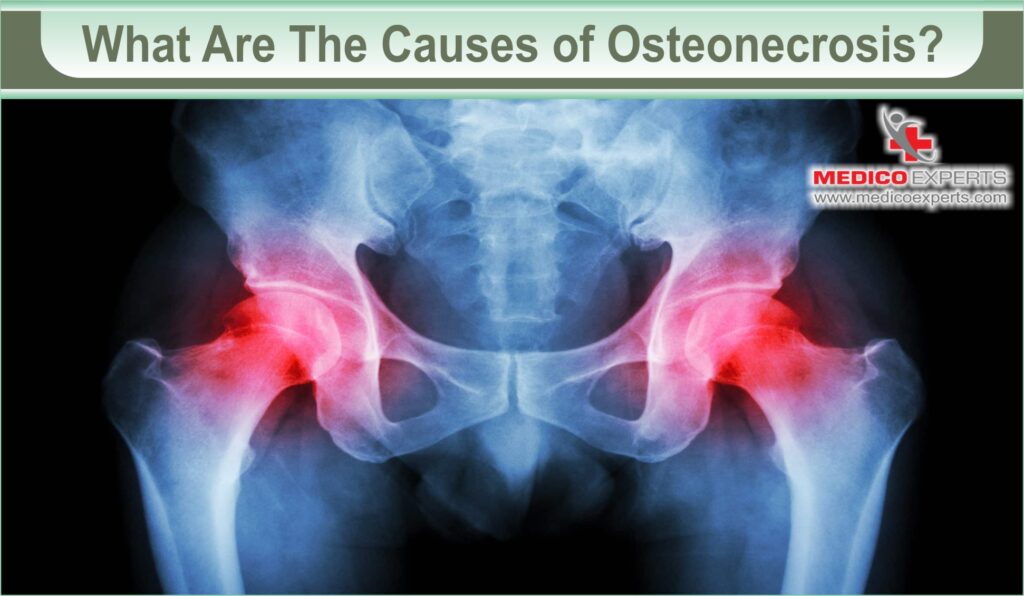
Before delving into the treatments, let’s explore the primary causes of osteonecrosis.
While it can be idiopathic (without an apparent cause), some known risk factors include:
- Trauma,
- Excessive alcohol consumption,
- Corticosteroid use, and
- Certain medical conditions.
Understanding the underlying causes is crucial in tailoring the right treatment plan for each patient.
What are the Symptoms of Osteonecrosis?
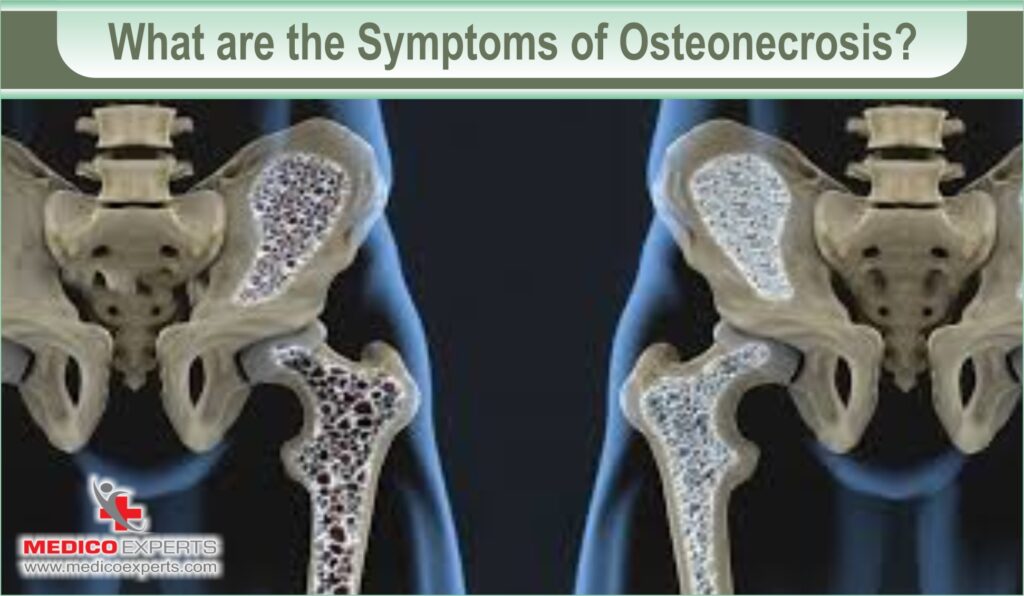
The specific symptoms a person experiences may depend on the location and extent of the affected bone.
Here are some common symptoms of osteonecrosis:
- Pain
- Stiffness
- Swelling
- Limited Mobility
- Crepitus: (Crepitus is a crackling or grating sound that can occur when moving the affected joint.)
- Muscle Atrophy (muscle weakness and atrophy around the affected joint may become noticeable)
- Difficulty Walking
Secondary Symptoms:
Depending on the specific joint affected, such as the hip or knee, patients might experience referred pain in nearby areas. For example, hip osteonecrosis can cause pain in the groin or buttocks, and knee osteonecrosis may lead to pain in the thigh or calf.
Late-Stage Symptoms:
It’s essential to note that the progression and severity of osteonecrosis can vary from person to person. Proper diagnosis and timely treatment can help improve outcomes and potentially prevent further joint damage.
Let’s go ahead and check out the treatment options for Osteonecrosis.
What Are Treatment Options for Osteonecrosis?
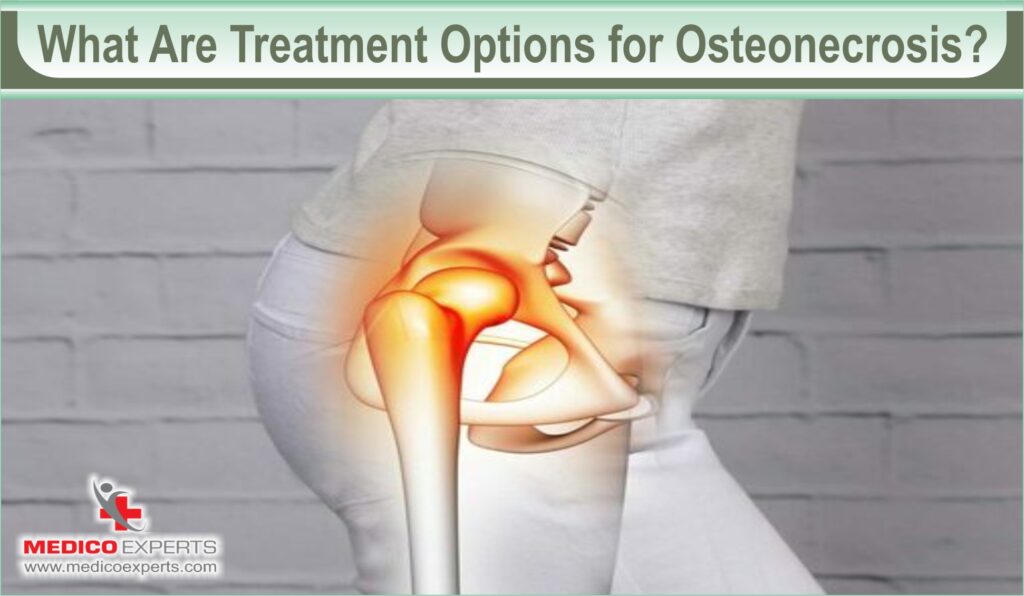
Let us explore the Osteonecrosis Treatment options in detail:
1. Medications
In the early stages of avascular necrosis, specific medications may be prescribed to alleviate symptoms:
1. Nonsteroidal Anti-Inflammatory Drugs (NSAIDs):
Nonprescription drugs like ibuprofen (Advil, Motrin IB) or naproxen sodium (Aleve) can be used to relieve pain associated with avascular necrosis. Stronger prescription NSAIDs are also available.
2. Osteoporosis Medications::
Certain medications may slow the progression of avascular necrosis, although the evidence of their effectiveness is mixed.
3. Cholesterol-Lowering Drugs:
Lowering cholesterol and reducing fat levels in the bloodstream may help prevent vessel blockages that contribute to avascular necrosis.
4. Medications to Enhance Blood Flow:
Iloprost (Ventavis) is a medication that may enhance blood flow to the affected bone. Its efficacy, however, requires further research.
5. Blood Thinners:
In cases of clotting disorders, blood thinners such as warfarin (Jantoven) might be prescribed to prevent the formation of clots in the blood vessels that supply the bones.
2. Therapy
Your healthcare provider may recommend the following therapeutic approaches:
A. Rest
Restricting physical activity and using crutches for several months can help reduce weight-bearing on the affected joint, potentially slowing down further damage to the bone.
B. Exercises
The primary goal of physical therapy in osteonecrosis treatment is to maintain or improve the joint’s range of motion while also addressing other critical aspects of the condition.
A physical therapist can instruct you in exercises designed to maintain or improve the joint’s range of motion.
Check below some of the exercise for patients suffereing from osteonecrosis:
1. Range of Motion Exercises:
This is vital for preventing joint stiffness and maintaining your ability to perform everyday activities comfortably.
2. Strength Training:
Building muscle strength not only supports the joint but also helps alleviate some of the stress and strain on the area, reducing discomfort and enhancing stability.
3. Pain Management:
Your physical therapist will work with you to identify and address these pain points, helping you achieve a better quality of life.
4. Functional Training:
Physical therapists will often incorporate functional exercises into your program, simulating real-life movements and activities.
5. Body Mechanics Education:
Your therapist will also educate you on proper body mechanics and movement patterns to minimize stress on the affected joint.
6. Adaptation and Assistive Devices:
In some cases, adaptive equipment or assistive devices may be recommended to make movements easier and safer.
Regular sessions with a physical therapist are essential to monitor your progress, adjust the exercises as needed, and ensure you are on the right track to regain function and alleviate pain.
C. Electrical Stimulation:
Electrical currents may stimulate the body to generate new bone tissue to replace the damaged bone.
Electrical stimulation can be applied directly to the affected area during surgery or through electrodes attached to the skin.
3. Conservative Management
For patients in the early stages of osteonecrosis, conservative management is often the first approach.
This involves:
- Lifestyle modifications,
- Pain management, and
- Physical therapy.
Additionally,
- Weight-bearing restrictions,
- Assistive devices, and
- Medications can help alleviate symptoms.
4. Osteonecrosis Surgery
In more advanced cases, surgery becomes a viable option. The type of surgical procedure depends on the location and extent of osteonecrosis.
Common surgical interventions include:
- Core decompression,
- Bone grafting, and
- Joint replacement.
Let’s take a closer look at osteonecrosis surgery.
- Core Decompression:
This minimally invasive procedure involves drilling a hole into the affected bone to relieve pressure and stimulate blood flow, promoting healing. It’s most effective in the early stages of osteonecrosis.
- Bone Grafting:
Bone grafting is often used in conjunction with core decompression. Healthy bone is transplanted to the affected area to support tissue regeneration.
- Joint Replacement:
When osteonecrosis leads to severe joint damage, joint replacement surgery, such as hip or knee replacement, may be necessary to restore mobility and alleviate pain.
5. Stem Cell Treatment for Osteonecrosis
In recent years, stem cell therapy has gained attention as a potential treatment option for osteonecrosis.
Stem cells have the remarkable ability to regenerate damaged tissue, making them an exciting prospect for patients seeking alternative treatments.
How Does StemCell Treatment Work?
Stem cell therapy for osteonecrosis involves the extraction of stem cells, typically from the patient’s bone marrow or fat tissue.
These cells are then injected into the affected area, where they can aid in tissue repair and regeneration.
What Is The Effectiveness Of The Stem Cell Treatment?
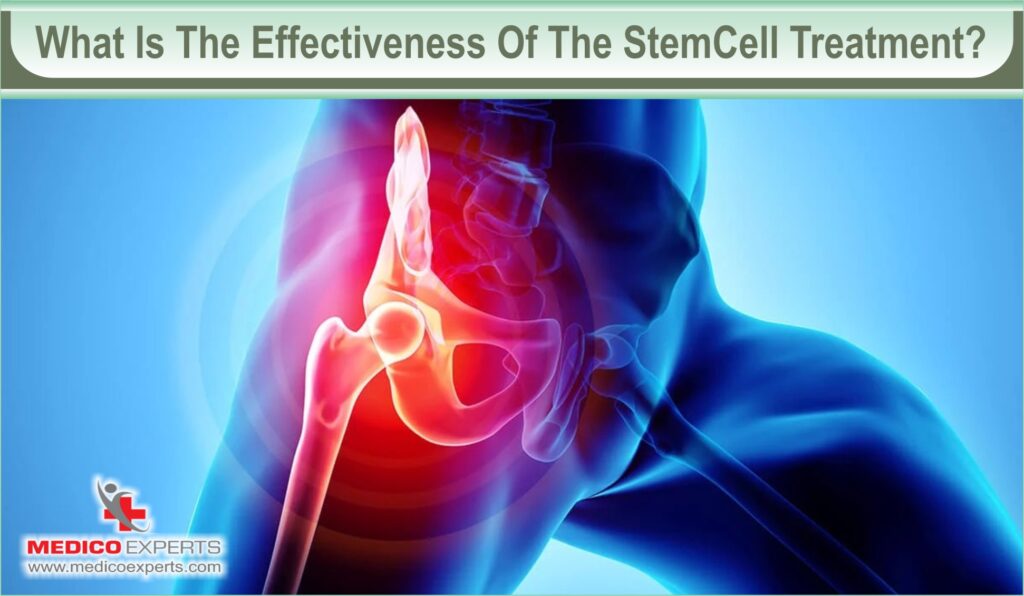
The effectiveness of stem cell treatment for osteonecrosis is a topic that has garnered significant interest and research in recent years.
Let’s explore its early stage, patient-specific outcomes, complementary approach, safety consideration, and consultation with specialists.
Early-Stage Osteonecrosis:
Some studies suggest that stem cell therapy can be particularly effective in early-stage cases of osteonecrosis. By introducing stem cells into the affected area, it is expected that they can promote tissue repair and regeneration.
The potential benefits include:
- Reducing pain,
- Improving joint function, and
- Potentially halting or
- Even reversing the progression of the disease.
Patient-Specific Outcomes:
The effectiveness of stem cell therapy can vary from patient to patient.
Individual factors such as:
- The stage and severity of osteonecrosis,
- The patient’s overall health, and
- The choice of stem cell source (bone marrow, fat tissue, etc.) can influence the results.
Patients should have realistic expectations and discuss potential outcomes with their healthcare providers.
Complementary Approach:
Stem cell therapy is often used in conjunction with other treatment modalities, such as core decompression or bone grafting.
Combining these approaches may yield more positive outcomes, especially in moderate to severe cases.
Safety Considerations:
Patients and healthcare providers should discuss the potential risks and benefits of this treatment, including:
- The risk of infection,
- Rejection, or
- Adverse reactions.
While stem cell therapy shows promise, it’s essential to consider safety.
Consultation with Specialists:
Patients should consult with orthopedic specialists or rheumatologists who are experienced in osteonecrosis and stem cell therapy.
These experts can assess whether stem cell treatment is a suitable option and guide patients through the decision-making process.
Conclusion
In the realm of osteonecrosis treatments, there is no one-size-fits-all solution. The right approach depends on the individual’s condition and its severity. Whether opting for conservative management, osteonecrosis surgery, or exploring innovative options like stem cell therapy, timely diagnosis and consultation with specialists are crucial steps on the path to recovery.
If you or a loved one is facing osteonecrosis, don’t hesitate to seek professional advice and explore the most suitable treatment options available. Remember, recovery is possible, and the journey towards regaining mobility and relieving pain begins with the first step – seeking expert guidance.For personalized information and guidance on osteonecrosis, consult a medicoexpert today. They can provide the support and insights you need to make informed decisions about your treatment journey. It is within your reach to live a healthier lifestyle.
FAQ :
Q1. What is the new treatment for osteonecrosis?
A. While there isn’t a single “new” treatment for osteonecrosis, stem cell therapy is a relatively recent and evolving approach that shows promise, especially in the early stages. However, traditional treatments like core decompression, bone grafting, and joint replacement remain effective and widely used.
Q2. Can you recover from osteonecrosis?
A. Recovery from osteonecrosis varies from patient to patient, depending on the stage and severity of the condition, as well as the chosen treatment. In the early stages, with appropriate treatment and lifestyle adjustments, many patients can experience significant improvement and regain their quality of life.
Q3. What are the treatment options for osteonecrosis?
A. The treatment options for osteonecrosis range from conservative management, which includes lifestyle modifications and pain management, to more invasive approaches such as surgery, including core decompression, bone grafting, and joint replacement. Stem cell therapy is an emerging option that shows promise.
Q4. Does osteonecrosis resolve?
A. Osteonecrosis does not always resolve on its own. Better outcomes can be achieved through early detection and intervention. While some cases may stabilize with conservative management, more advanced cases often require surgical or alternative treatments for better long-term results.
Q5. How can I find osteonecrosis specialists?
A. To find an osteonecrosis specialist, start by consulting your primary care physician or orthopedic specialist for referrals. They can guide you to healthcare professionals with expertise in diagnosing and treating osteonecrosis. Additionally, the team Medicoexpert is here to help you at every step, book an appointment today!



